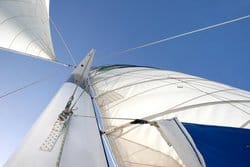 Reefing a cruising catamaran is normally determined by wind speed and not the action of the boat itself. It is difficult to determine when a catamaran is over powered because being a multihull it does not heel significantly. Because it cannot heel to spill wind from the sails, the only way to escape the wind pressure on the sails is to accelerate. If the boat is overpowered you can often see this by looking at the leeward hull- if it is being pushed down into the water excessively or the scoop has water up to the steps, you are carrying too much sail and need to reef. Always remember the old saying ” if you think that you should have reefed then you should have already done so”.
The best solution is to have a wind speed rule on when to reef that is based on the APPARENT wind speed. This will differ from boat to boat as they all perform differently based on beam and bouyancy. Here is a guideline to get you started.
Reefing a cruising catamaran is normally determined by wind speed and not the action of the boat itself. It is difficult to determine when a catamaran is over powered because being a multihull it does not heel significantly. Because it cannot heel to spill wind from the sails, the only way to escape the wind pressure on the sails is to accelerate. If the boat is overpowered you can often see this by looking at the leeward hull- if it is being pushed down into the water excessively or the scoop has water up to the steps, you are carrying too much sail and need to reef. Always remember the old saying ” if you think that you should have reefed then you should have already done so”.
The best solution is to have a wind speed rule on when to reef that is based on the APPARENT wind speed. This will differ from boat to boat as they all perform differently based on beam and bouyancy. Here is a guideline to get you started.
- When you are seeing wind speed between 18 and 20 Knots put in the first reef
- When the wind gets to 25 knots it is time for reef number 2
- When the wind is constantly at 28 to 30 knots put in the third reef
- When the wind is blowing above 30 Knots and gusting, it is time to put the jib away completely and sail with a fully reefed mainsail only
- In extreme conditions the fully reefed main can be set up to spill wind by luffing which will enable you to sail in very strong winds without damaging the rig or sails.
Tips For Squalls
- If you see a squall coming that looks like it is going to be bad, roll the jib up completely (easier to deal with just the one sail) and get the boat onto a beam reach. By sailing on a beam reach you will have good control of the boat and there is very little chance of making a mistake.
- If the wind gets too strong you can spill wind by luffing the main, most catamaran mains are fully battened so it will not flog if properly controlled. You cannot do this with a jib because it will flog and damage the sail.
- What often happens in a squall, is that the wind direction shifts, so all you need to do is helm the boat and keep it on a beam reach no matter what the change of wind direction is until the squall goes through. Once the squall has gone through the wind will stabilize and you can get back on course and redeploy the jib. Squalls usually does not last very long and you can track it on your radar.
- If it really gets bad start the engines to keep yourself positioned as described above.
Sail With Us to Learn


Week-Long Liveaboard Courses
Rare RYA Classes & Certifications
Catamaran Guru’s real-life practical methods combined with up-to-date sailing theory in lessons aboard recent model catamarans…or your own boat!
Prepare for certifications or take the first step aboard to embark on your dream life of boat ownership or cruising
Classes in S Florida and the Bahamas.

Estelle Cockcroft
Catamaran Guru Co-Founder
Estelle Cockcroft is a seasoned sailor, catamaran expert, and co-founder of Catamaran Guru. With over 70,000 NM sailed and 30+ years aboard, she empowers new cruisers with expert advice on liveaboard life, yacht ownership, and ocean adventures.





